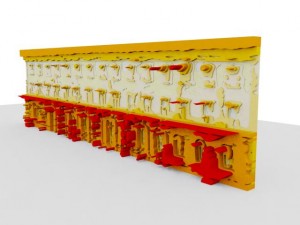Three-dimensional visualization of thermal information from facades
Apr 26th, 2010 | By Dr. Jukka Krisp | Category: Featured Articles, NewsInfrared images or so-called thermal images are increasingly available. Usually the data is acquired and stored, but a thorough interpretation and presentation of the data is done insufficiently. Within ongoing research at the TUM/LfK we deal with the innovative representation of thermal building information.
These include coating steps, rectangular shapes or homogeneous network structures in a three-dimensional environment. Adapted methods concerning the cartographic representations are applied and modified to fit the specific requirements. Figure 1 shows a façade with the color coded scaled thermal information. This is the “classic” approach of visualizing the thermal information acquired by an infrared camera.

Thermal image showing the heat radiation from the facade of the technical university Munich main building
Through the mapping of color and the combination with computer graphic techniques of the “Light Ray Tracing” the impression has been reinforced plastic. A layer level representation with a used progressive elevation shows the spatial relationships of the thermal behavior. Representing the thermal information as a body, which has three dimensions because it adds a height to the area, has some advantages; thus we expect a faster detection of the prevailing situation on a thermal facade.
Figure 2 visualizes the thermal information classified into seven heat classes. Additionally the classified temperature values are used as w-values adapted to the computer graphic texture mapping. It gives the model a third dimension on the local façade uv-coordination system.

The thermal image data classified temperature values are used as w-values to give the model a third dimension
A body shadow is added to provide a sufficient shadow for all objects and to make them appear more “plastic”. Modeling the classified changing temperature values using a three-dimensional method can help to identify heat corridors or specific bottlenecks concerning the temperature changes, which might be underestimated in the two-dimensional visualization.It can also help to stress certain components of the information.
Selecting and intensifying of specific parts of the information is especially important in the communication of the temperature information. Using the third dimension, with appealing color combinations, can significantly assist the communication process. Frequently collected data includes a timestamp and that enables us to visualize the data including a fourth dimension. Further research will investigate methods to visualize a fourth (time) dimension to reflect significant changes in thermal information.
Dipl.Ing. Holger Kumke, Dr. Jukka Krisp
Technische Universität München (TUM)
Kartographie (LFK), Arcisstraße 21, 80333 München, Germany